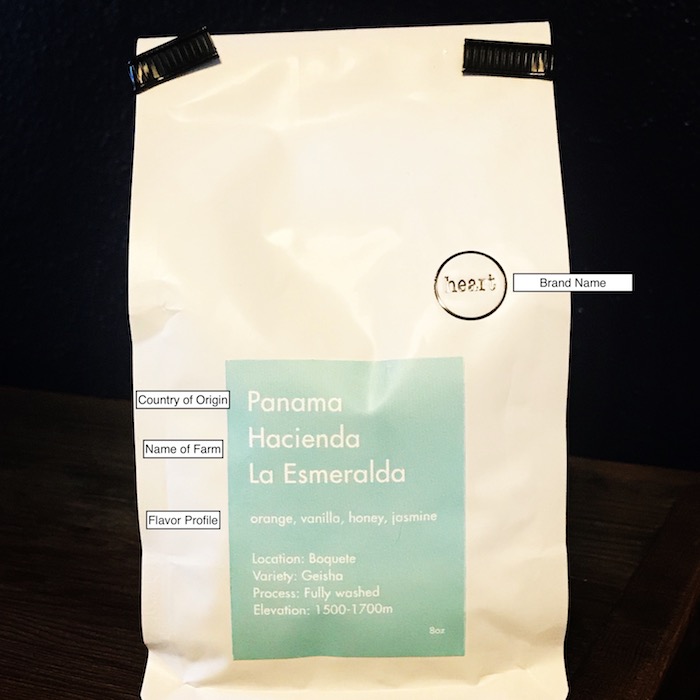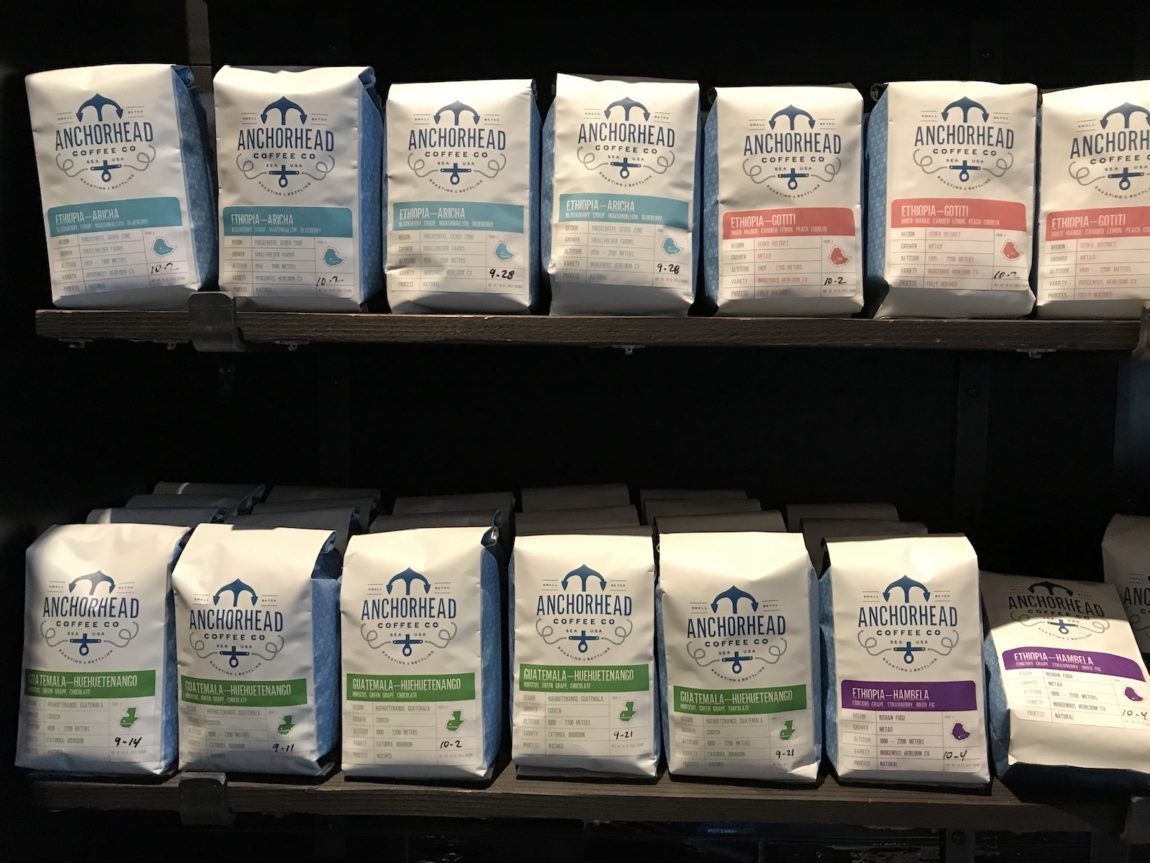Knowing how to read a coffee bag label is important as a specialty coffee consumer.
If you are a newcomer to the world of specialty coffee you may start to notice information on coffee bags that you haven’t seen before. Large commercial coffee companies typically only tell you the country of origin or the name of the blend on their coffee bags. However, quality specialty coffee roasters provide you with a lot more information.
How To Read A Coffee Bag Label: Examples
Let’s look at a few example coffee bag labels…

Anchorhead Coffee Natural Processed Ethiopia Aricha

Heart Coffee Roasters Hacienda La Esmeralda Geisha
Brand Name:
The name of the coffee roaster or coffee shop.
Region of Origin:
Specialty coffee roasters will often tell us both the country of origin as well as the specific region.
Name of Farm:
This may also be the name of the co-op or processing mill.
Bean varietal(s):
This is the specific varietal of Arabica coffee. Some coffees are single varietal while others have multiple varietals. Common varietals include Bourbon, Typica, and Caturra. Coffee varietals are similar to grape varietals used to make wine. Just like Merlot tastes different from Pinot Noir, Arabica coffee varietals have subtle differences in flavor from one another. However, sticking with this wine analogy, terroir or the growing location and environment also matter. A Willamette Valley Pinot Noir may taste very different from a Napa Valley Pinot. Similarly, a Bourbon coffee grown in different regions may taste different. The difference between coffee varietals can be extremely subtle so don’t expect to be able to taste a difference.
Altitude:
Farmers grow coffee at different altitudes, which can affect the quality and flavor. Altitude is most commonly reported in MASL or meters above sea level. As a generalization, higher is better when it comes to altitude. Higher altitude coffees are typically more complex, acidic and bright while lower altitude coffees typically have a simpler, mild, and chocolate flavor. As a general rule we can consider 1500 MASL to be high, 1000-1400 MASL to be low, and 1400-1500 is somewhere in the middle.
Roasting Date:
This is the date the coffee roaster actually roasted the coffee (not the sell by date). Coffee is best when fresh. I would advise buying coffee within several week from when it was roasted (my rule of thumb is typically within 3-4 weeks). This will ensure you are drinking the best, freshest coffee. If a bag of coffee does not have a roast date on the bag do not buy it! Let me repeat that. Do not buy a bag of coffee that does not have a roast date on the bag. You have no idea what you are getting!
Flavor Profile:
The flavor profile the the coffee roastery’s opportunity to describe what the coffee tastes like when brewed well. Don’t worry, it will still taste like coffee! But as you start tasting more specialty coffee you may start to notice some flavors you’ve never tasted before…hints of honey, subtle citrus flavors, or even bold blueberry flavors. As you explore and try different coffees pay attention to what kind of flavors you enjoy. Once you know what you enjoy you will be able to use the flavor profile on the bag as a guide to which coffees to buy.
Processing Method:
The processing method describes how coffee producers process the cherry (fruit) to separate the green coffee bean from the coffee cherry. In general there are only a few different processing methods. Some coffee farmers use a specific processing methods to achieve a desired flavor. Other times, the coffee producer chooses a processing method based on factors like cost, availability of water, etc. A full description of processing techniques is beyond the scope of this discussion. But lets talk about what you need to know in order to make an informed coffee buying decision.
Washed (Fully Washed) Method:
Many specialty coffee roasters prefer washed processed coffees because of their clean, lively characteristics with nuanced, complex flavors. In this method the coffee cherries are processed through a mill, which removes the fruit or pulp. The beans then are placed in a large vat of water to remove the surrounding gel-like sugary substance called mucilage. The coffee producers then dry the beans either in a machine or on beds under sunlight.
Natural Processing Method:
The natural process is also known as the sun-dried process. In this method coffee producers dry the coffee cherries in the sun without removing any of the fruit, similar to drying grapes to make raisins. The coffee cherries are then processed in a mill to remove the dried fruit and covering layers. The natural process can result in coffee that is very unique with strong fruit flavors like blueberry (the natural processed Ethiopia Aricha coffee from Anchorhead is an excellent example of blueberry flavor in a coffee). Some people describe natural processed coffees to have a wine-like flavor and they tend to have a fuller body than washed coffees. While some people to not like these qualities, I personally love an interesting, quality natural processed coffee.
Honey (Pulped Natural) Method:
The honey and pulped natural methods are actually two different methods but they are so similar that I will lump them together. This method is basically a hybrid between washed and natural processing. Coffee producers mill the coffee to remove the fruit. Immediately after the milling process the beans are dried instead of being soaked in water tanks like with the washed process. This process leaves a small amount of fruit and mucilage surrounding the drying coffee bean, adding some unique flavors. Coffee producers from Costa Rica have recently popularized the honey process.
Semi-Washed (Wet-Hulled) Method:
Coffee producers in Indonesia commonly use the semi-washed or wet-hulled method. In this method the coffee is processed much like the washed method, it is milled, washed, and briefly dried. However, before the drying process is complete producers remove the protective parchment layer that surrounds the coffee bean. They then dry the coffee bean further without the parchment layer. In all other methods the parchment layer is left surrounding the bean until the coffee is ready to be transported. This method results in coffee that is deep green in color and has unique woody, green, and tobacco flavors common in Indonesian and Sumatran coffees.
Ground or Whole Bean:
Many large chain coffee companies sell their coffee either as whole beans or ground. You have likely seen the words “whole bean” or “ground” on a coffee bag in the grocery store. Many specialty coffee roasters and shops only sell their coffee as whole beans to preserve freshness. As a result, they do not typically include this information on specialty coffee bag labels. If you don’t have a home coffee grinder I would suggest you read my prior post on why grinders are so important.
Conclusion and Recommendations:
You have made it to the end. You are now an expert coffee bag reader and specialty coffee consumer. Congratulation!
I have a final recommendation for you.
Start trying different specialty coffees. Explore and find out for yourself what you like.
Do you like the clean, subtle taste of washed coffees or the funky, fruity, and wine-like taste of some natural processed coffees? Do you prefer coffee from a certain country or region?
Have fun and happy coffee drinking!





No Comments